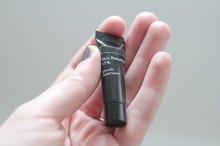How to Wash Your Face When You Take Accutane
Accutane--a brand name for the generic drug isotretinoin--is a potent medication used to treat moderate and severe forms of acne. As the American Osteopathic College of Dermatology explains, Accutane permanently heals acne in approximately half of those who take it, making it the most effective skin-clearing medication available. Despite its benefits, Accutane also yields a number of side effects--some of which mandate changes in your skin-care regimen. To counter the skin sensitivity and dryness this drug often creates, adopt a gentle, non-abrasive routine when washing your face.
Select a mild, non-medicated face wash that contains no alcohol, scrubbing agents or astringent ingredients. Products labeled "non-comedogenic" or "oil-free" are unlikely to aggravate acne, according to Acne.org, and cleansers marked with the terms "non-overdrying" or "non-irritating" will help minimize the dryness associated with Accutane use 3. Avoid using face washes that contain salicylic acid or benzoyl peroxide, two acne medications that dry the skin.
How to Care for Oily Skin That Is Sensitive
Learn More
Wash your face using warm water, your skin cleanser and your hands 3. Rub the cleanser gently over your face with your fingertips, avoiding contact with your eyes, and then rinse it off. To minimize skin irritation, limit each wash to 10 seconds or less. Do not scrub your face with abrasive fabrics like sponges or washcloths; these can cause your skin to chafe while you're taking Accutane.
Dab your skin dry with a soft towel. Avoid harsh rubbing motions, which can worsen Accutane-induced skin irritation.
How to Handle Peeling Skin While on Accutane
Learn More
Allow your face to dry for five to 15 minutes before using any additional face products or cosmetics. According to SkinCarePhysicians.com, applying substances to your skin immediately after you wash your face can result in skin irritation.
Apply a small amount of gentle moisturizer to your face. Using a moisturizer can help restore your skin's hydration and prevent the flaking, peeling and redness that Accutane users sometimes experience. As with your face wash, choose a product labeled "oil-free" or "non-comedogenic" to ensure the ingredients won't trigger acne breakouts 3.
Tips
Avoid washing your face more than twice per day. As Acne.org explains, over-washing your face does not improve acne and may worsen the skin irritation you experience while taking Accutane.
Consult your dermatologist if you're unsure which facial cleanser or moisturizer to use. Your doctor may be able to recommend or prescribe one.
If you wear cosmetics, choose oil-free brands, preferably with a sun protection factor (SPF); Accutane increases the skin's sensitivity to sunlight and may make you more susceptible to burns.
Warnings
Stop using any cleansers or moisturizers that worsen your acne, increase facial redness, cause skin pain or trigger allergic reactions.
Strictly adhere to your physician's instructions while taking Accutane. When used improperly, this medication can have severe side effects--including birth defects if you take the medication during pregnancy.
Related Articles
References
- Drugs.com: Accutane Information
- SkinCarePhysicians.com: 12 Ways to Get Better Results From Acne Treatment
- Acne.org: Acne Cleansers and How to Wash Your Face
- Chularojanamontri L, Tuchinda P, Kulthanan K, Pongparit K. Moisturizers for acne: what are their constituents? J Clin Aesthet Dermatol. 2014;7(5):36-44.
- Decker A, Graber EM. Over-the-counter acne treatments: A review. J Clin Aesthet Dermatol. 2012;5(5):32-40.
- Dréno B, Bettoli V, Araviiskaia E, Sanchez Viera M, Bouloc A. The influence of exposome on acne. J Eur Acad Dermatol Venereol. 2018;32(5):812-9. doi:10.1111/jdv.14820
- Zaenglein AL, Pathy AL, Schlosser BJ, et al. Guidelines of care for the management of acne vulgaris. J Am Acad Dermatol. 2016;74(5):945-73. doi:10.1016/j.jaad.2015.12.037
Writer Bio
Denise Minger, an independent researcher, writer, editor and public speaker, published her first book, "Death by Food Pyramid," in January 2014. Passionate about health, she runs a blog at rawfoodsos.com dedicated to debunking bad nutritional science, and offers health consultations for individuals with special dietary goals.









